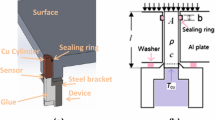Abstract
The presence of a subsurface thermocouple hole can lead to a local disturbance of the temperature field in a sample and to a discrepancy between the thermal history measured by the thermocouple and the thermal history in an area without a thermocouple. This phenomenon also leads to errors in the surface heat flux calculated using an inverse heat conduction model, which relies on the acquired thermal history data. This article analyzes the factors that influence the temperature discrepancy caused by a subsurface thermocouple hole. A technique called the “equivalent depth” technique is proposed to compensate for the disturbance of the temperature field due to the presence of a thermocouple hole. This technique involves off-setting the location of the thermocouple position based on the radius of the thermocouple hole. A verification of this technique for the calculation of the surface heat flux using an inverse heat conduction model with measured thermal history data is presented.
Similar content being viewed by others
References
J.V. Beck and H. Hurwicz: J. Heat Transfer, 1960, vol. 82, pp. 27–36.
J.I. Masters and S. Stein: Rev. Sci. Instrum., 1956, vol. 27, pp. 1065–69.
D. Li: Ph.D. Thesis, The University of British Columbia, Vancouver, 2003.
C.T. Kidd: NASA Langley Measurement Technology Conference, Langley Research Center, Hampton, VA, 1992, pp. 31–50.
L.I. Kiss, T. Meenken, A. Charette, Y. Lefebvre, and R. Lévesque: Light Metals, 2002, pp. 981–85.
J.V. Beck: J. Heat Transfer, 1962, vol. 84, pp. 124–32.
V.N. Eliseev and V.A. Solovov: J. Eng. Phys., 1983, vol. 45 (5), pp. 1232–36.
S.L. Balakovskii and É.F. Baranovskii: J. Eng. Phys., 1987, vol. 52 (1), pp. 106–09.
M.H. Attia and L. Kops: J. Eng. Industry, 1986, vol. 108 (4), pp. 241–46.
M.H. Attia and L. Kops: J. Eng. Industry, 1988, vol. 110 (1), pp. 7–14.
M.H. Attia and L. Kops: J. Eng. Industry, 1993, vol. 115 (4), pp. 444–49.
D. Li and M.A. Wells: Metall. Mater. Trans. B, 2005, vol. 36B, pp. 343–54.
E. Caron, M.A. Wells, D. Sediako, and S.G. Hibbins: Magn. Technol., 2005, pp. 229–34.
Author information
Authors and Affiliations
Rights and permissions
About this article
Cite this article
Caron, E., Wells, M.A. & Li, D. A compensation method for the disturbance in the temperature field caused by subsurface thermocouples. Metall Mater Trans B 37, 475–483 (2006). https://doi.org/10.1007/s11663-006-0031-x
Received:
Issue Date:
DOI: https://doi.org/10.1007/s11663-006-0031-x




